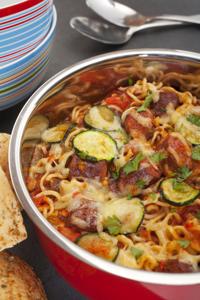What do three foods from disparate places — Armenian pilaf, risotto and sopa seca, the Mexican “dry soup” — have in common?
During my days as the food editor of The Detroit News, an Armenian American friend took it upon himself to teach me how to make pilaf. He showed me how to toast the broken-up vermicelli and the rice in butter before adding the stock. It was, he said, the way his grandmother taught him to make it.
As I ate it with pleasure, I realized that this must be the dish that inspired the boxed mix Rice-A-Roni, which used to call itself “the San Francisco treat.” Many Armenians settled in the Bay area in the post-genocide diaspora, and they would have brought their customary foods with them.
Later, learning to make risotto and paella, I saw again the method of sautéing the rice in butter or oil until translucent before adding the stock. The technique, as with Armenian pilaf, keeps the grains of rice separate as they cook.
When I first saw someone prepare sopa seca in Chiapas, Mexico, I saw the technique again. Browning the fideo noodles before adding the stock helps them stay separate, too.
Somehow, cooks in all four places — Armenia, Italy, Spain and Mexico — discovered this technique and put it to good use in their kitchens.
I put it to good use in my own kitchen, too.
This version of sopa seca can be made with noodles or rice, and when it’s topped with cheese and chorizo before baking, it makes a filling main dish. Made with rice, it’s perhaps closer to paella or risotto. Often, however, I skip the cheese and chorizo completely, and serve sopa seca as a side dish. It’s equally good that way.
Because the noodles are toasted, they maintain their shape and don’t mush out when they’re cooked in the sauce.
And because they’re cooked in the sauce, every skinny little noodle is imbued with the sauce’s flavor.
It’s OK to use bouillon cubes here if that’s all you have. While homemade chicken stock would be the gold standard, our pandemic kitchens sometimes lack a key ingredient we wish we had on hand. No reason to apologize — just mind the salt.
And if you happen to have some cooked chicken to shred, or some cooked shrimp, or shredded pork, toss that in toward the end of cooking so it can warm through. Those you feed will thank you.
SOPA SECA, TUCSON STYLE
Makes about 4 servings
If you don’t have vermicelli or fideo noodles, you can make this with raw white rice. Substitute 1 cup rice for the noodles in that case and follow the procedure as written.
INGREDIENTS
2 ancho, pasilla or Oaxacan dried chiles, with stems removed
2 clove garlic, minced
1/2 cup chopped onion
1 teaspoon oregano, Mexican if possible
1 cup tomato puree (a little more than half of a 14-ounce can)
3 cups chicken stock (you can use bouillon cubes here if you need to)
3/4 cup olive oil
6 ounces uncooked fideo or vermicelli, broken if in a nest
Salt, to taste
1 Mexican chorizo, casing removed, cooked and crumbled
3/4 cup grated queso fundido, queso Oaxaca or queso quesadilla
3/4 cup grated Cheddar cheese
Mexican crema, sour cream, or crème fraiche, for serving
PREPARATION
Toast the chiles in a small dry skillet over medium heat until aromatic and pliable, turning them once or twice. This will take about five minutes. Set aside to cool.
When the chiles have cooled, remove the seeds, and then snip them into a blender jar. Add the garlic, onion, oregano and tomato puree. Process on top speed until smooth. Strain the mixture through a fine sieve if you wish to be fancy. Set the mixture aside.
In a large saucepan over medium-high heat, bring the stock to a boil, remove from heat and set aside.
Heat the oil in a large, deep skillet over medium heat. Add the noodles or rice and cook, stirring, until golden brown. Transfer to a colander set over a bowl using a slotted spoon. Pour off all but a couple of tablespoons of oil and return the skillet to heat.
Pour the chile mixture into the skillet and cook, stirring occasionally, until thickened slightly, about five minutes. Add the stock and season with salt to taste — if you’re using bouillon cubes, you probably won’t need salt. Bring the mixture to a boil and add the noodles or rice. Reduce the heat to a simmer, cover the pan and cook until the pasta or rice absorbs the liquid, about 15 minutes for noodles, about 20 minutes for rice. The mixture will still be a little saucy.
While the noodles or rice cook, heat the oven to 400 degrees. When the noodles or rice are cooked, place them into a shallow 2-quart casserole. Sprinkle the cooked chorizo over the noodles or rice. Toss the queso and Cheddar together and sprinkle over the top. Transfer to the oven and bake until the cheeses melt, about 10 to 12 minutes.
Serve at once with a dollop of crema, sour cream, or crème fraiche atop each serving.





